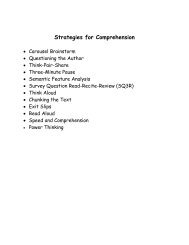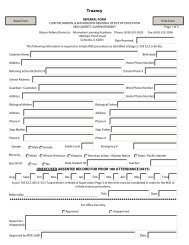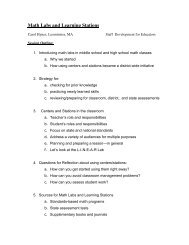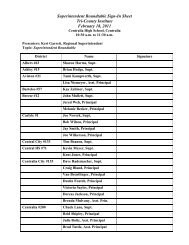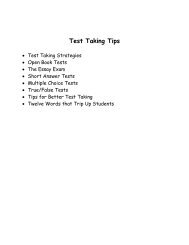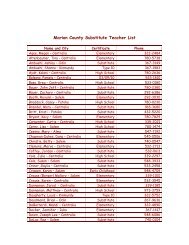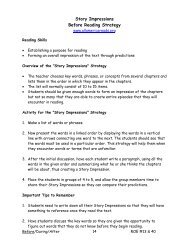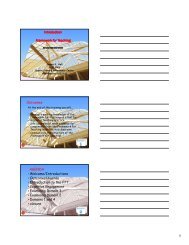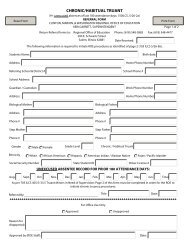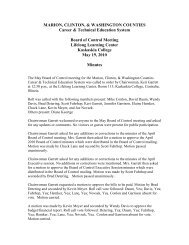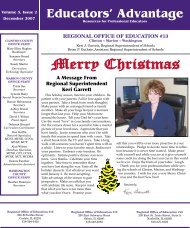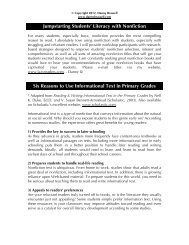Educators' Advantage - Regional Office of Education #13
Educators' Advantage - Regional Office of Education #13
Educators' Advantage - Regional Office of Education #13
You also want an ePaper? Increase the reach of your titles
YUMPU automatically turns print PDFs into web optimized ePapers that Google loves.
ake writing a team effort with<br />
hese new online resources<br />
ttp://www.google.com/educators.<br />
eeklyreader.html<br />
Google Inc. and Weekly Reader<br />
ave teamed up to <strong>of</strong>fer free tools<br />
nd materials to help educators teach<br />
digital buddy writing,” which is<br />
here two or more students work<br />
ogether from different computers to<br />
rite and revise the same paper at<br />
he same time. “Revision writing is<br />
critical piece <strong>of</strong> the writing process,<br />
nd more and more, teachers are<br />
sing the concept <strong>of</strong> working with a<br />
writing buddy’ to help make writing<br />
ore fun and collaborative, and to<br />
each students the importance <strong>of</strong> havng<br />
support throughout the creative<br />
rocess,” explained Cristin Frodella,<br />
roduct manager <strong>of</strong> Google’s educaion<br />
initiatives, in a recent blog post<br />
escribing the partnership. The free<br />
esson plan, available on Good for<br />
ducators, contains tips and checkists—culled<br />
from teachers all over<br />
he country—for incorporating digital<br />
uddy writing into the classroom,<br />
sing Google’s free Google Docs online<br />
ord processor. With this new curiculum,<br />
students can work together<br />
nline to review each others’ work<br />
imultaneously and watch as their<br />
eers’ comments and edits appear<br />
ew federal web site aims to link<br />
esearch with practice<br />
ttp://dww.ed.gov<br />
The U.S. Department <strong>of</strong> <strong>Education</strong> has<br />
aunched a new web site aimed at giving<br />
ducators advice about effective teachng<br />
practices and examples <strong>of</strong> ways to<br />
mplement these practices to improve stuent<br />
achievement. Called “Doing What<br />
orks,” the new site <strong>of</strong>fers a user-friendy<br />
interface to help users quickly locate<br />
eaching practices that have been found<br />
ffective by the department’s research<br />
rm, the Institute <strong>of</strong> <strong>Education</strong> Sciences,<br />
nd similar organizations. In addition, it<br />
rovides examples <strong>of</strong> possible ways this<br />
esearch can be used to help students<br />
each their full potential. Teachers intersted<br />
in successful strategies for helping<br />
nglish-language learners, for example,<br />
an watch a video <strong>of</strong> eight strategies that<br />
eachers at one school use to teach vocabuary.<br />
Coming soon, the department says,<br />
ill be similar resources in such areas<br />
s early childhood education, high school<br />
eform, literacy, school restructuring, cog-<br />
Educators’ <strong>Advantage</strong> • Volume 3, Issue 3 • Page 10<br />
EDUCATIONAL RESOURCES<br />
instantly and legibly across multiple<br />
computers, Google says—whether<br />
they are in the same lab or in completely<br />
different locations anywhere<br />
around the world.<br />
Watch science in action at the South<br />
Pole through archived webcasts<br />
http://www.exploartorium.edu/icestories<br />
In a series <strong>of</strong> webcasts held in celebration<br />
<strong>of</strong> the International Polar<br />
Year (2207-2008), educators at the<br />
Exploratorium in San Francisco will<br />
be talking with scientists at McMurdo<br />
Station near the South Pole about<br />
the many research projects they’re<br />
conducting. For instance, this season<br />
three giant helium balloons will<br />
launch near McMurdo Station and<br />
circulate in circumpolar air currants<br />
above Antarctica, collecting data<br />
about cosmic rays—very high-energy<br />
particles that zip through the galaxy<br />
at nearly the speed <strong>of</strong> light. If conditions<br />
permit, Exploatorium educators<br />
will be talking with the balloon<br />
scientists from their ice facility<br />
at Williams Field, where the giant<br />
balloons are inflated and launched<br />
and their flights are tracked. The<br />
museum makes these webcasts available<br />
and educators also can explore<br />
its archive <strong>of</strong> previous South Pole<br />
webcasts, which feature research on<br />
nitive learning, and math and science.<br />
“Educators need to know what works, and<br />
this online library <strong>of</strong> resources will build a<br />
bridge from research to action,” said U.S.<br />
Secretary <strong>of</strong> <strong>Education</strong> Margaret Spellings<br />
in announcing the site. “Its translates<br />
research-based practices into examples <strong>of</strong><br />
tools that support and improve classroom<br />
instruction.”<br />
CoSN launches technology leadership<br />
wiki for small school districts<br />
http://www.cosn.org/wiki<br />
The Consortium for School Networking<br />
(CoSN) has created a new online resource<br />
designed to help technology leaders in<br />
small school districts. Called the Small<br />
School District Technology Leadership<br />
wiki, the site allows users not only to learn<br />
from the resources provided by CoSN and<br />
other sources, but also to contribute to the<br />
site by adding their own best practices,<br />
tips, strategies, case studies, and resources.<br />
“CoSN recognizes that technology<br />
leadership concerns and needs <strong>of</strong> small<br />
districts are typically impacted by a dif-<br />
CURRICULUM<br />
LEADERSHIP<br />
penguins, ice cores taken from miles<br />
beneath the earth’s surface, and construction<br />
<strong>of</strong> a new 10-meter telescope<br />
at the South Pole.<br />
New podcasts aim to make science<br />
more accessible<br />
http://feeds.feedburner.com/bytesizescience<br />
Seeking to make science more<br />
fun and easily accessible for today’s<br />
students, the American Chemical<br />
Society (ACS) has launched Bytesize<br />
Science, an educational, entertaining<br />
new podcast for young listeners.<br />
Bytesize Science translates cuttingedge<br />
scientific discoveries from ACS’s<br />
36 peer-reviewed journals into stories<br />
for young listeners about science,<br />
health, medicine, energy, food, and<br />
other topics. New installments are<br />
posted every Monday and are available<br />
free <strong>of</strong> charge. The program’s<br />
archive includes items on environmental<br />
threats to killer whales, a scientific<br />
explanation for why some people<br />
love chocolate, and some unlikely<br />
new uses for compact discs. The podcaster<br />
for Bytesize Science is Adam<br />
Dylewski, an ACS science writer and<br />
recent graduate <strong>of</strong> the University<br />
<strong>of</strong> Wisconsin-Madison with degrees<br />
in genetics and science communication.<br />
Dylewski spent his college<br />
career immersed in science and jour-<br />
ferent set <strong>of</strong> resource, personnel, and even<br />
expertise constraints that are experienced<br />
in larger or medium-sized districts,” said<br />
Keith Krueger, CoSN’s chief executive.<br />
“The content found on the CoSN wiki may<br />
prove useful for any district but is particularly<br />
focused on the specific needs and<br />
challenges <strong>of</strong> small school districts.” The<br />
wiki aims to help with systematic technology<br />
planning for school districts with<br />
student populations <strong>of</strong> 2,500 or less in particular.<br />
Of the more than 14,000 school<br />
districts in the United States, nearly 75<br />
percent have student populations <strong>of</strong> less<br />
than 2,500, CoSN says.<br />
Let “Route 21” help steer your efforts<br />
to implement 21st-century teaching<br />
http://www.21stcenturyskills.org/route21<br />
Numerous polls suggest that stakeholders<br />
increasingly believe U.S. schools<br />
should do more to prepare students to<br />
succeed in today’s rapidly evolving world<br />
by teaching so-called “21st-century skills,”<br />
such as global literacy, problem solving,<br />
critical thinking, innovation, and creativ-<br />
nalism, writing down-to-earth explanations<br />
<strong>of</strong> important discoveries as<br />
a weekly science columnist for The<br />
Daily Cardinal, UW-Madison’s student<br />
newspaper. Later, he continued<br />
to translate science news as a reporter<br />
for UW-Madison’s communications<br />
<strong>of</strong>fice and for The Why Files, an<br />
award-winning science news site with<br />
a witty, fun edge.<br />
Health <strong>Education</strong> Curriculum<br />
Analysis Tool (HECAT)<br />
CDC announces the initial release<br />
<strong>of</strong> the Health <strong>Education</strong> Curriculum<br />
Analysis Tool (HECAT)<br />
www.cdc.gov/healthyyouth<br />
The Health <strong>Education</strong> Curriculum<br />
Analysis Tool (HECAT) can help<br />
school districts, schools, and others<br />
conduct a clear, complete, and consistent<br />
analysis <strong>of</strong> health education curricula<br />
based on the National Health<br />
<strong>Education</strong> Standards and CDC’s<br />
Characteristics <strong>of</strong> Effective Health<br />
<strong>Education</strong> Curricula. The HECAT<br />
results can help schools select or<br />
develop appropriate and effective<br />
health education curricula and<br />
improve the delivery <strong>of</strong> health education.<br />
The HECAT can be customized<br />
to meet local community needs and<br />
conform to the curriculum requirements<br />
<strong>of</strong> the state or school district.<br />
ity. To help schools implement such 21stcentury<br />
teaching and learning practices,<br />
the Partnership for 21st Century Skills<br />
has launched a new online resource called<br />
Route 21, a one-stop shop for related tools<br />
and information. Route 21 showcases how<br />
21st-century skills can be taught through<br />
changes in standards, assessments, pr<strong>of</strong>essional<br />
development, curriculum and<br />
instruction, and learning environments.<br />
It harnesses Web 2.0 features to allow<br />
users to tag, rank, organize, collect, and<br />
share Route 21 content based on their<br />
personal interests. Users can contribute<br />
to the site’s resources by uploading relevant<br />
examples, as well as sharing their<br />
reactions and insights on implementing<br />
21st-century skills in their state, district,<br />
or school. The site represents the first<br />
comprehensive online resource for highquality<br />
content, best practices, relevant<br />
reports, articles, and research to help educators<br />
implement 21st-century teaching<br />
practices and learning outcomes, according<br />
to the Partnership.



